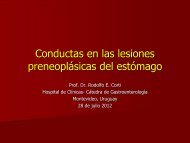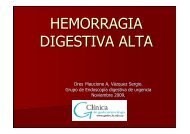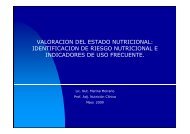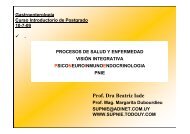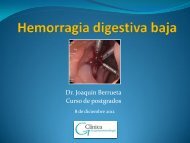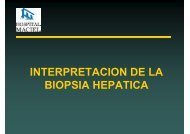Tratamiento de la infección por H. Pylori - ClÃnica de ...
Tratamiento de la infección por H. Pylori - ClÃnica de ...
Tratamiento de la infección por H. Pylori - ClÃnica de ...
You also want an ePaper? Increase the reach of your titles
YUMPU automatically turns print PDFs into web optimized ePapers that Google loves.
Infección <strong>por</strong> Helicobacter pylori:<br />
¿qué <strong>de</strong>bemos hacer en 2012<br />
Dr. Henry Cohen<br />
Profesor <strong>de</strong> Gastroenterología<br />
Facultad <strong>de</strong> Medicina, Montevi<strong>de</strong>o, Uruguay<br />
Presi<strong>de</strong>nte WGO (OMGE)<br />
Miembro Titu<strong>la</strong>r Aca<strong>de</strong>mia Nacional <strong>de</strong> Medicina<br />
Maestro <strong>de</strong> <strong>la</strong> Gastroenterología Americana
P<strong>la</strong>n <strong>de</strong> <strong>la</strong> exposición<br />
• Generalida<strong>de</strong>s sobre tratamiento<br />
• Objetivos<br />
• Resistencia<br />
• Primera línea<br />
• Segunda línea<br />
• Tercera línea<br />
• Noveda<strong>de</strong>s<br />
• Resumen
Limitaciones al uso <strong>de</strong> ATB en Hp<br />
• La BMG limita penetración <strong>de</strong> ATB y efecto sobre Hp.<br />
• Los ATB usados para tratamiento <strong>de</strong> Hp no<br />
<strong>de</strong>sarrol<strong>la</strong>n altas concentraciones en mucus gástrico.<br />
Vakil, N. Gastroenterology & Hepatology Volume 5, Issue 1 January 2009
Para aumentar <strong>la</strong>s<br />
concentraciones <strong>de</strong> ATB:<br />
• Se combinan ATB con IBP.<br />
• Se combinan dos ó más ATB.
¿Porqué usamos IBP<br />
• volumen <strong>de</strong> JG, [ATB].<br />
• <strong>la</strong> viscosidad <strong>de</strong>l mucus, su permeabilidad.<br />
• <strong>la</strong> estabilidad <strong>de</strong> los ATB:<br />
- C<strong>la</strong>ritro es muy sensible a <strong>la</strong> <strong>de</strong>gradación <strong>por</strong> el ácido<br />
(VM < 1 hora a pH 2).<br />
- Amoxi tiene VM <strong>de</strong> 15 horas a pH 2.<br />
- Metro es muy estable a cualquier pH (VM > 800 h)<br />
Vakil, N. Gastroenterology & Hepatology Volume 5, Issue 1 January 2009
P<strong>la</strong>n <strong>de</strong> <strong>la</strong> exposición<br />
• Generalida<strong>de</strong>s sobre tratamiento<br />
• Objetivos<br />
• Resistencia<br />
• Primera línea<br />
• Segunda línea<br />
• Tercera línea<br />
• Noveda<strong>de</strong>s<br />
• Resumen
¿Qué es un tratamiento exitoso<br />
Clásicamente se consi<strong>de</strong>ra al que<br />
supere el 80% <strong>de</strong> erradicación.
¿Nuevos objetivos<br />
• Control <strong>de</strong> erradicación <strong>de</strong> rutina para conocer mejor <strong>la</strong>s<br />
ten<strong>de</strong>ncias sobre resistencia.<br />
• Pasar <strong>de</strong> estudios en los que se comparan p<strong>la</strong>nes <strong>de</strong><br />
tratamiento entre sí, a otros en los que <strong>la</strong>s nuevas terapias<br />
requieren llegar a un nivel preestablecido (ej. grado A o B).<br />
Graham DY, Lu H, Yamaoka Y. Drugs. 2008;68(6):725-36<br />
Graham DY. Clinical Gastroenterology and Hepatology, 2009;7:145-148<br />
Graham, DY, Fishbach, L. Gut Online First, published on June 4, 2010 as 10.1136/gut.2009.192757<br />
Graham, DY, Fishbach, L. NEJM 1 363;6 nejm.org august 5, 2010
Scoring clinical studies into effectiveness categories using prespecified criteria<br />
would allow clinicians to objectively i<strong>de</strong>ntify and compare regimens<br />
D. Graham et al, Helicobacter 12: 275–278<br />
• Propone que sólo los<br />
grado A sean indicados.<br />
• Los grado B pue<strong>de</strong>n ser<br />
usados si no se alcanzan<br />
los A.<br />
• En <strong>la</strong> mayor parte <strong>de</strong> <strong>la</strong>s<br />
regiones el triple p<strong>la</strong>n<br />
<strong>de</strong>bería ser abandonado<br />
<strong>por</strong> inaceptable.
P<strong>la</strong>n <strong>de</strong> <strong>la</strong> exposición<br />
• Generalida<strong>de</strong>s sobre tratamiento<br />
• Objetivos<br />
• Resistencia<br />
• Primera línea<br />
• Segunda línea<br />
• Tercera línea<br />
• Noveda<strong>de</strong>s<br />
• Resumen
Consecuencias <strong>de</strong> <strong>la</strong> resistencia a H. pylori<br />
• Cepa sensible a C<strong>la</strong>ritro:<br />
erradicación 87,8%.<br />
• Sensible a nitroimidazoles:<br />
97%.<br />
• Resistente a C<strong>la</strong>ritro: 18.3%.<br />
• La resistencia primaria a<br />
C<strong>la</strong>ritro es un fuerte factor<br />
predictivo <strong>de</strong> fal<strong>la</strong> <strong>de</strong><br />
erradicación.<br />
• Resistente a nitroimidazoles:<br />
72.6%.<br />
• El impacto <strong>de</strong> <strong>la</strong> resistencia<br />
a Metro es más improbable.<br />
Broutet, Aliment Pharmacol Ther, 2003<br />
T.-U. Wheeldon , Aliment Pharmaco Ther, 2004
Resistencia a H. pylori en América<br />
(modificado <strong>de</strong> L.G. Vaz Coelho)<br />
País Autor Metro C<strong>la</strong>ritro<br />
Brasil<br />
Colombia<br />
Chile<br />
Prazeres<br />
(2002)<br />
Trespa<strong>la</strong>cios<br />
(2010)<br />
González<br />
(2001)<br />
53% 9.8%<br />
81% 17.7%<br />
42% 2%<br />
Costa Rica Lang (2004) 40.4% 5.3%<br />
México Torres (2001) 80% 24%<br />
Uruguay<br />
Cohen<br />
(2008)<br />
36% 12%<br />
Argentina Corti (2004) 39.5% 6%<br />
USA Duck (2004) 25.1% 12.9%<br />
Cuba Gutiérrez (05),<br />
L<strong>la</strong>nes (10)<br />
85% 3%, 10%
Uruguay<br />
• Se estudiaron 2 pob<strong>la</strong>ciones: una general en 2001<br />
(PG) y otra <strong>de</strong> afro<strong>de</strong>scendientes (AD) en 2006.<br />
• En PG no hubo R a c<strong>la</strong>ritro, pero en AD, llegó a 19.4%.<br />
• ¿Diferencias pob<strong>la</strong>cionales o tem<strong>por</strong>ales<br />
• Metro igual en ambas (36%).<br />
• No hubo R a tetra ni amoxi.<br />
• Escasa R a levo, igual en ambas.<br />
Rev Esp Enferm Dig (Madrid) Vol. 101. N.° 11, pp. 757-762, 2009
Resistencia a ATB: aplicación clínica<br />
Maastricht III (Florencia 2005)<br />
• El umbral <strong>de</strong> resistencia a c<strong>la</strong>ritro <strong>por</strong> encima<br />
<strong>de</strong>l cual se <strong>de</strong>bería hacer estudios <strong>de</strong><br />
susceptibilidad o bien no se <strong>de</strong>bería usar <strong>la</strong><br />
droga es 15-20 %.<br />
• En <strong>la</strong> práctica diaria, no es necesario realizar<br />
tests <strong>de</strong> susceptibilidad al metronidazol.
Resistencia: ultraresumen<br />
• La elección <strong>de</strong>l tratamiento más efectivo <strong>de</strong>bería<br />
basarse en <strong>la</strong> prevalencia <strong>de</strong> <strong>la</strong> R a ATB.<br />
• La R a c<strong>la</strong>ritro es el más im<strong>por</strong>tante factor<br />
predictivo <strong>de</strong> fal<strong>la</strong> <strong>de</strong> tratamiento.<br />
• Baja R a c<strong>la</strong>ritro: triple p<strong>la</strong>n.<br />
• Alta R a c<strong>la</strong>ritro: buscar alternativas.
P<strong>la</strong>n <strong>de</strong> <strong>la</strong> exposición<br />
• Generalida<strong>de</strong>s sobre tratamiento<br />
• Objetivos<br />
• Resistencia<br />
• Primera línea<br />
• Segunda línea<br />
• Tercera línea<br />
• Noveda<strong>de</strong>s<br />
• Resumen
Infección <strong>por</strong> H. pylori: tratamiento<br />
erradicador <strong>de</strong> primera elección<br />
Triple p<strong>la</strong>n ¨clásico¨<br />
• IBP + C<strong>la</strong>ritromicina 500 mg + Amoxicilina 1g, cada 12 hs.<br />
• Todos los IBP son simi<strong>la</strong>res si se asocian con dos ATB.<br />
• El uso previo <strong>de</strong> IBP no influye en el resultado.<br />
Malfertheiner P et al, Aliment Pharmacol Ther, 2002 (Maastricht 2)<br />
Mégraud F et al, Gut 2004<br />
Gisbert JP, Med Clin, 2005<br />
Annibale B et al, Am J Gastoenterol 1997
Consenso <strong>de</strong> Maastricht III, Florencia 2005<br />
¿Cuál es <strong>la</strong> primera línea <strong>de</strong> tratamiento<br />
‣IBP, c<strong>la</strong>ritromicina, amoxicilina o metronidazol es el tratamiento<br />
recomendado en pob<strong>la</strong>ciones con resistencia a c<strong>la</strong>ritro < 15-20%.<br />
‣En pob<strong>la</strong>ciones con resistencia a metronidazol < 40%, es<br />
posible usar IBP, c<strong>la</strong>ritro, metro.<br />
‣Los tratamientos cuádruples son alternativas en primera opción<br />
<strong>de</strong> tratamiento.
Meta-análisis <strong>de</strong> tratamiento<br />
triple vs. cuádruple<br />
%<br />
8 ECA<br />
N=1585<br />
Luther et al. Am J Gastroenterol.2008;103:S397
Ventajas <strong>de</strong>l cuádruple p<strong>la</strong>n<br />
• Es útil para superar <strong>la</strong> R a metro.<br />
• No está influido <strong>por</strong> <strong>la</strong> R a macrólidos.<br />
• Pue<strong>de</strong> usarse si <strong>la</strong> R a C<strong>la</strong>ritro es mayor <strong>de</strong> 15%.
Desventajas <strong>de</strong>l cuádruple p<strong>la</strong>n<br />
• Disponibilidad <strong>de</strong>l bismuto.<br />
• Es el tratamiento más complejo y con < compliance.
Duración <strong>de</strong>l tratamiento<br />
• En pacientes con DNU, el tratamiento <strong>de</strong> 7 días es<br />
menos efectivo que el <strong>de</strong> 10.<br />
• En pacientes con UP, ambos p<strong>la</strong>nes son simi<strong>la</strong>res.<br />
Calvet X et al, Am J Gastroenterol, 2005<br />
El-Omar EM, Nat Clin Pract Gastroenterol Hepatol, 2006
Eficacia <strong>de</strong> tratamientos cortos<br />
y <strong>la</strong>rgos para H.pylori<br />
<strong>Tratamiento</strong> Duración (días)<br />
Incremento en<br />
erradicación<br />
14 vs 7 9% - 12%<br />
Triple<br />
10 vs 7 3%<br />
14 vs 10 2%<br />
Cuádruple 10 - 14 vs 7 6%<br />
Calvet X et al. APT 2000;14:603-9<br />
Fishbach LA et al APT 2004;20:1071-82<br />
Ford A. et al. Can J Gastroenterol 2003; 17: 36-40
Duración <strong>de</strong>l triple p<strong>la</strong>n:<br />
ultraresumen<br />
• UGD: 7 días.<br />
• Dispepsia funcional: 10 días.<br />
De Boer WA et al, Eur J Gastroenterol Hepatol, 2001<br />
Calvet X et al, Am J Gastroenterol 2005
Resultados actuales <strong>de</strong>l triple p<strong>la</strong>n ¨clásico¨<br />
• Trabajos recientes <strong>de</strong> USA, Europa y Asia: tasas <strong>de</strong><br />
erradicación entre 50 y 75%.<br />
• Causa: R a c<strong>la</strong>ritromicina.<br />
• Uso <strong>de</strong> genéricos o copias sin a<strong>de</strong>cuado control <strong>de</strong><br />
calidad pue<strong>de</strong> explicar fal<strong>la</strong>s en el tratamiento.<br />
• ¡Buscar alternativas!<br />
D. Vaira et al, Ann Intern Med, 2007, 146: 556-563<br />
N. Jaffri et al, Ann Intern Med, 2008, 148: 923-931<br />
WGO Gui<strong>de</strong>line, 2010
¨Las tasas <strong>de</strong> erradicación en <strong>la</strong> mayoría <strong>de</strong> los<br />
países occi<strong>de</strong>ntales han caído a niveles<br />
inaceptables, probablemente <strong>de</strong>bido a aumento en<br />
<strong>la</strong> resistencia a antibióticos. En particu<strong>la</strong>r <strong>la</strong> R a<br />
c<strong>la</strong>ritromicina fue i<strong>de</strong>ntificada como uno <strong>de</strong> los<br />
factores más im<strong>por</strong>tantes…¨<br />
J. Gisbert, J. Pajares, European J of Int Med, 2010
¿Es igual en América Latina<br />
• Comparan TP (LAC) <strong>por</strong> 14 días con TS (LA, LCM) <strong>por</strong> 10<br />
o TC (LACM) <strong>por</strong> 5<br />
• 1463 pacientes randomizados<br />
• Erradicación: TP: 82.2%, TS: 76.5, TC: 73.6<br />
• El TP fue mejor que los <strong>de</strong>más en los 7 países<br />
• Conclusión: el TP <strong>por</strong> 14 días es preferible al TS <strong>por</strong> 10 o<br />
al TC <strong>por</strong> 5, como tratamiento empírico para infección<br />
<strong>por</strong> Hp en diversas pob<strong>la</strong>ciones <strong>de</strong> América Latina<br />
E R Greenberg et al. Lancet, vol. 378, Aug 6, 2011
¿Es igual en América Latina<br />
Dudas: - Países con alta prevalencia <strong>de</strong> CG<br />
- TP <strong>por</strong> 14 días<br />
- Uso <strong>de</strong> metro<br />
- Uso <strong>de</strong> copias o genéricos
Alternativas
¿Es útil <strong>la</strong> levofloxacina en el<br />
tratamiento inicial<br />
Primer ECA que compara c<strong>la</strong>ri con levo<br />
en Triple P<strong>la</strong>n (TP) y Secuencial (TS).<br />
115 pacientes<br />
randomizados<br />
<strong>por</strong> grupo<br />
tto. <strong>de</strong> 10 días<br />
Por Protocolo<br />
%<br />
ITT<br />
%<br />
OCA 66 64<br />
OLA 82.6 80.8<br />
SEC. OACM 80.8 76.5<br />
SEC. OALM 85.2 82.5<br />
J . Molina –Infante et al. Aliment Pharmacol Ther 31, 1077–1084, 2010
¿Es útil <strong>la</strong> levofloxacina en el<br />
tratamiento inicial<br />
• OCA consiguió menor erradicación que los otros tres p<strong>la</strong>nes,<br />
entre los que no hubo DS.<br />
• Compliance y efectos adversos simi<strong>la</strong>res.<br />
• Propuesta: reservar levo para tratamientos <strong>de</strong> rescate.<br />
J . Molina –Infante et al. Aliment Pharmacol Ther 31, 1077–1084, 2010
Efficacy of 5-Day Levofloxacin-Containing Concomitant<br />
Therapy in Eradication of Helicobacter pylori Infection<br />
Fe<strong>de</strong>rico A et al, Gastroenterology, July 2012<br />
• Introducción: ensayo randomizado <strong>de</strong> no-inferioridad para<br />
<strong>de</strong>terminar si 5 días <strong>de</strong> TC con levofloxacina es tan eficiente y<br />
seguro como un TS <strong>de</strong> 10 días en ptes no tratados<br />
• Métodos: 2 grupos: - 5 días <strong>de</strong> TC (esomeprazol 40,<br />
amoxicilina 1 g, levofloxacina 500, y tinidazol 500, todos dos<br />
veces al día; n: 90)<br />
- 10 días <strong>de</strong> TS (esomeprazol 40,<br />
amoxicilina 1g, <strong>por</strong> 5 días, seguidos <strong>de</strong> esomeprazol 40,<br />
levofloxacina 500 y tinidazol 500, todos dos veces al día <strong>por</strong><br />
5 días más, n: 90)
Efficacy of 5-Day Levofloxacin-Containing Concomitant<br />
Therapy in Eradication of Helicobacter pylori Infection<br />
Fe<strong>de</strong>rico A et al, Gastroenterology, July 2012<br />
• Resultados: - ITT: TC 92.2% y TS 93.3%<br />
- PP: 96.5% y 95.5%<br />
• Prevalencia <strong>de</strong> resistencia e inci<strong>de</strong>ncia <strong>de</strong> efectos<br />
adversos comparables<br />
• Conclusiones: un TC <strong>de</strong> 5 días con levofloxacina es tan<br />
efectivo y seguro en <strong>la</strong> erradicación <strong>de</strong> <strong>la</strong> infección <strong>por</strong><br />
H. pylori como un TS <strong>de</strong> 10 días
<strong>Tratamiento</strong>s iniciales<br />
con levofloxacina: ultraresumen<br />
• Erradicación: 72 a 96%.<br />
• Útil en pacientes con R a metro y tetra simultánea.<br />
• La R a levo se adquiere rápidamente, va en aumento y reduce<br />
mucho el éxito <strong>de</strong>l tratamiento.<br />
• Ten<strong>de</strong>ncia a reservar<strong>la</strong> para rescate.<br />
J. Gisbert, J. Pajares, 2010
P<strong>la</strong>n <strong>de</strong> <strong>la</strong> exposición<br />
• Generalida<strong>de</strong>s sobre tratamiento<br />
• Objetivos<br />
• Resistencia<br />
• Primera línea<br />
• Segunda línea<br />
• Tercera línea<br />
• Noveda<strong>de</strong>s<br />
• Resumen
Infección <strong>por</strong> H. pylori:<br />
tratamiento erradicador <strong>de</strong> segunda elección<br />
Cuádruple p<strong>la</strong>n<br />
• IBP cada 12 hs. + subcitrato bismuto 120 mg cada 6 hs. +<br />
tetraciclina 500 mg cada 6 hs + metronidazol 500 mg cada 8 hs.<br />
• Duración: 7 a 10 días.<br />
• Eficacia <strong>de</strong> 76%.<br />
• Sin efectos secundarios serios.<br />
Gisbert JP et al, Rev Esp Enferm Dig, 2003<br />
Gisbert JP et al, Aliment Pharmacol Ther, 1999<br />
Hojo M et al, Scand J Gastroenterol 2001;36-690-700<br />
Ford AC et al, World J Gastroenterol 2008; 14:7361-70
Consenso <strong>de</strong> Maastricht IV<br />
GUT, 2012<br />
¿Cuál es <strong>la</strong> segunda línea <strong>de</strong> tratamiento recomendada<br />
El cuádruple p<strong>la</strong>n con bismuto o un TP con levo son<br />
<strong>la</strong>s mejores opciones.
Cuádruple p<strong>la</strong>n<br />
Resumen<br />
El cuádruple p<strong>la</strong>n es una buena alternativa<br />
para superar <strong>la</strong> R a metro y a<strong>de</strong>más, no se<br />
ve influenciado <strong>por</strong> <strong>la</strong> R a macrólidos.
<strong>Tratamiento</strong> erradicador <strong>de</strong> segunda elección<br />
con Levofloxacina<br />
• IBP + Amoxi 1 g, ambos cada 12 hs. + Levo 500 mg/ día.<br />
• Duración: 7 a 10 días.<br />
• Resultados: - ITT: 42 a 91%.<br />
- PP: 77 a 95%.<br />
- Efectos secundarios simi<strong>la</strong>res.<br />
• Es ya consi<strong>de</strong>rado el segundo p<strong>la</strong>n <strong>de</strong> elección.<br />
Nista EC et al, Aliment Pharmacol Ther, 2003<br />
Zullo A, Dig Liver Dis , 2003<br />
Gisbert JP, Gastroenterol Hepatol, 2005<br />
Nista et al, Am J Gastroenterol, 2006<br />
Antos et al, Helicobacter, 2006<br />
Gisbert et al, Am J Gastroenterol 2008<br />
Di Caro et al, Digestive and Liver Dis, 41 (2009) 480-485
Levofloxacina: limitaciones<br />
• El Hp <strong>de</strong>sarrol<strong>la</strong> rápidamente R a levofloxacina.<br />
• Pue<strong>de</strong> ser un ATB útil <strong>por</strong> corto tiempo.<br />
Egan et al, Helicobacter 2008<br />
Gisbert et al, AJG, 2008<br />
Spahr et al, J Hepatol 2001
P<strong>la</strong>n <strong>de</strong> <strong>la</strong> exposición<br />
• Generalida<strong>de</strong>s sobre tratamiento<br />
• Objetivos<br />
• Resistencia<br />
• Primera línea<br />
• Segunda línea<br />
• Tercera línea<br />
• Noveda<strong>de</strong>s<br />
• Resumen
¡Pregunta c<strong>la</strong>ve!<br />
¿Cuántas veces intentamos erradicar<br />
To treat or not to treat
The twists and turns of fate<br />
From Economist.com, Aug 21st 2008<br />
“Helicobacter pylori tiene reputación <strong>de</strong><br />
causar úlceras y cáncer. Sin embargo,<br />
perseguirlo hasta su extinción pue<strong>de</strong><br />
ser un error”<br />
Martin B<strong>la</strong>ser, microbiólogo, New York University School of Medicine
Does Helicobacter pylori protect against asthma and allergy<br />
Martin J B<strong>la</strong>ser,Yu Chen, Joan Reibman<br />
Gut, May 2008 Vol 57 No 5<br />
“Una asociación inversa entre H. pylori y asma infantil,<br />
rinitis alérgica y atopía es cada vez más obvia…<br />
También <strong>la</strong> re<strong>la</strong>ción con el menor riesgo <strong>de</strong> enfermeda<strong>de</strong>s<br />
<strong>de</strong>l esófago, incluido cáncer, y posiblemente con obesidad y<br />
diabetes …<br />
Es posible que para <strong>la</strong> mayoría <strong>de</strong> los individuos, H. pylori<br />
sea beneficioso en <strong>la</strong> infancia y <strong>de</strong>letéreo más tar<strong>de</strong> en <strong>la</strong><br />
vida…”
Contemp<strong>la</strong>ting the Future without Helicobacter pylori and<br />
the Dire Consequences Hypothesis<br />
Graham D et al, Helicobacter 12 (Suppl. 2): 64–68, 2007<br />
¨Las hipótesis <strong>de</strong> <strong>la</strong>s terribles consecuencias que<br />
provocaría <strong>la</strong> erradicación <strong>de</strong> <strong>la</strong> infección han probado<br />
ser intentos erróneos <strong>de</strong> culpar <strong>de</strong> algunos <strong>de</strong> los<br />
problemas que encara el mundo mo<strong>de</strong>rno a un patógeno<br />
que fue y es responsable <strong>de</strong> mucho sufrimiento,<br />
morbilidad y mortalidad.<br />
Es hora <strong>de</strong> unirnos para erradicarlo y relegar al H. pylori,<br />
junto con <strong>la</strong> virue<strong>la</strong> y <strong>la</strong> poliomielitis, a <strong>la</strong> lista <strong>de</strong><br />
los in<strong>de</strong>seables que ya han sido duramente golpeados¨.
¿Qué hacer <strong>de</strong>spues <strong>de</strong> dos<br />
fracasos terapéuticos<br />
1. Cultivo y antibiograma: requiere endoscopía,<br />
es caro y <strong>la</strong>borioso, sensibilidad no es 100%,<br />
<strong>de</strong>termina sensibilidad a algunos ATB,<br />
no es igual S in-vitro que in vivo.<br />
2. Realizar tratamiento empírico: no repetir ATB,<br />
sobre todo C y M.<br />
IMPORTANTE: sea cual fuere <strong>la</strong> opción elegida,<br />
hacerlo en centros especializados.<br />
Gisbert JP et al, Helicobacter, 2005<br />
Mégraud F et al, Aliment Pharmacol Ther, 2003
Consenso <strong>de</strong> Maastricht IV<br />
GUT, 2012<br />
¿Cuál es <strong>la</strong> tercera línea <strong>de</strong> tratamiento recomendada<br />
Luego <strong>de</strong> <strong>la</strong> fal<strong>la</strong> <strong>de</strong>l segundo p<strong>la</strong>n, el tratamiento<br />
<strong>de</strong>be ser guiado <strong>por</strong> el estudio <strong>de</strong> <strong>la</strong> susceptibilidad<br />
antimicrobiana, si es posible.
<strong>Tratamiento</strong> empírico:<br />
opciones <strong>de</strong> ATB<br />
• Levofloxacina.<br />
• Rifabutina: - Muy susceptible, no se conocen cepas R.<br />
- Dosis: 150 mg x 2 x 14 días con IBP y amoxi.<br />
- 61% éxitos.<br />
- Alerta con mielotoxicidad y mayor R a M. TBC.<br />
• Furazolidona: útil según disponibilidad. 65% <strong>de</strong> éxitos.<br />
Perri F, Aliment Pharmacol Ther, 2000<br />
Bock H, J Clin Gastroenterol, 2000<br />
Isakov V, Aliment Pharmacol Ther, 2002<br />
Treiber G, Helicobacter, 2002<br />
Vaz Coelho LG et al, Aliment Pharmacol Ther, 2005<br />
Qasim et al, Alim Pharmacol Ther, 2005<br />
Gisbert et al, Alim Pharmacol Ther, 2006<br />
Van <strong>de</strong>r Poorte et al, Alim Pharmacol Ther, 2007<br />
González Carro et al, J Gastroenterol Hepatol, 2007<br />
Suzuki et al, Digestion, 2009
P<strong>la</strong>n <strong>de</strong> <strong>la</strong> exposición<br />
• Generalida<strong>de</strong>s sobre tratamiento<br />
• Objetivos<br />
• Resistencia<br />
• Primera línea<br />
• Segunda línea<br />
• Tercera línea<br />
• Noveda<strong>de</strong>s<br />
• Resumen
¿Cómo mejorar los resultados<br />
<strong>de</strong>l tratamiento<br />
• Mayor duración <strong>de</strong>l tratamiento “clásico”.<br />
• <strong>Tratamiento</strong>s luego <strong>de</strong> fracaso: asegurar cumplimiento,<br />
cambiar <strong>de</strong> ATB (levofloxacina, rifabutina, furazolidona),<br />
cuádruple p<strong>la</strong>n, tratamientos secuenciales o concomitantes.<br />
Caval<strong>la</strong>ro et al, Helicobacter, oct.2006<br />
Malfertheiner et al, Eur Gastroentrol Rev, 2005<br />
Car<strong>de</strong>nas et al, Am J Epi<strong>de</strong>miol, 2005<br />
Du Bois et al, Am J Gastroenterol, 2005<br />
Susuki et al, Alim Pharmaco Ther, 2006<br />
Miehlke et al, Alim Pharmaco Ther, 2006
<strong>Tratamiento</strong> secuencial<br />
• Es una alternativa al triple p<strong>la</strong>n.<br />
• No es más que un doble p<strong>la</strong>n seguido <strong>de</strong> uno triple (5+5).<br />
• Objetivo primario: superar R a c<strong>la</strong>ritro.<br />
• Fase <strong>de</strong> inducción disminuye <strong>la</strong> carga bacteriana, para<br />
aumentar <strong>la</strong> eficacia <strong>de</strong> <strong>la</strong> segunda.<br />
• Otra ventaja: amoxi previene <strong>la</strong> aparición <strong>de</strong> R secundaria<br />
a c<strong>la</strong>ritro y facilita su acción.<br />
O´Connor et al, Helicobacter,14 (Suppl. 1): 46-51, Oct 2009<br />
Gisbert JP et al, J Clin Gastroenterol, Vol. 44, Number 5, May-June 2010
<strong>Tratamiento</strong> secuencial<br />
Drogas Dosis Duración<br />
IBP + Amoxicilina 1 g x 2 5 d.<br />
IBP, C<strong>la</strong>ritromicina<br />
500 mg, Tinidazol 500<br />
x 2 5 d.<br />
Zullo et al. Aliment Pharmacol Ther. 2003;17:719
¿Porqué es mejor el TS<br />
• ¿Por <strong>la</strong> administración secuencial<br />
• ¿Porque se usan 3 ATB en lugar <strong>de</strong> 2<br />
• ¿Por el tinidazol que no se usa en el TP<br />
• ¿Porque dura 10 días<br />
Gisbert JP et al, J Clin Gastroenterol, Vol. 44, Number 5, May-June 2010
<strong>Tratamiento</strong> secuencial<br />
• Metaanálisis <strong>de</strong> 10 ECA con 2747 pacientes.<br />
• TS superior a triple p<strong>la</strong>n en pacientes sin tratamiento<br />
previo (93.4 vs 76.9%).<br />
• Cumplimiento y efectos secundarios simi<strong>la</strong>res.<br />
• Mejores resultados en fumadores, DNU, R a c<strong>la</strong>ritro o<br />
imidazoles, no influye Cag A o carga bacteriana.<br />
Jaffri et al, Ann Intern Med, 2008<br />
Gisbert JP et al, J Clin Gastroenterol, Vol. 44, Number 5, May-June 2010
Meta-análisis <strong>de</strong> tratamiento<br />
secuencial vs. triple p<strong>la</strong>n<br />
10 ECA<br />
Secuencial<br />
n=2,747<br />
Triple<br />
n=1,363<br />
Jaffri et al, Ann Int Med, 2008
<strong>Tratamiento</strong> secuencial según<br />
nitroimidazol utilizado<br />
ITT<br />
Metronidazol 84.1%<br />
Tinidazol 97.4%<br />
Podría <strong>de</strong>berse a mayor VM <strong>de</strong>l tinidazol<br />
Choi et al, 2008<br />
Ruiz-Obaldia et al, 2008<br />
Sánchez-Delgado et al, 2008<br />
Wu et al, 2008<br />
Vaira et al, 2009
Compliance tratamiento secuencial vs TP<br />
Consumo <strong>de</strong> más <strong>de</strong><br />
90% <strong>de</strong> <strong>la</strong><br />
medicación<br />
<strong>Tratamiento</strong><br />
Secuencial<br />
Triple<br />
P<strong>la</strong>n<br />
92.6% 94%<br />
Efectos secundarios 9.9% 9.8%<br />
Interrupción <strong>de</strong>l<br />
tratamiento<br />
0.003% 0.007%<br />
¿Es igual en <strong>la</strong> práctica que en ensayos<br />
Zullo et al, 2007
Limitaciones <strong>de</strong>l TS<br />
• <strong>Tratamiento</strong> complejo.<br />
• En pacientes mayoritariamente italianos.<br />
• No útil en alérgicos a penicilina.<br />
• Si fal<strong>la</strong>, dificulta<strong>de</strong>s para tratamiento alternativo.
Análisis <strong>de</strong> últimos resultados <strong>de</strong>l TS<br />
En los últimos estudios (2008-9), se observa<br />
una ten<strong>de</strong>ncia <strong>de</strong>creciente (entre 80 y 90%).<br />
Gisbert JP et al, J Clin Gastroenterol, Vol. 44, Number 5, May-June 2010
¿Qué hacer si fal<strong>la</strong> el<br />
tratamiento secuencial<br />
• Usar triple p<strong>la</strong>n con levo <strong>por</strong> 10 días.<br />
86% <strong>de</strong> erradicación.<br />
• Otra opción: CP con bismuto.<br />
100% <strong>de</strong> erradicación.<br />
Zullo et al. Therapy. 2006<br />
Shehada et al, Helicobacter, 2007
<strong>Tratamiento</strong> secuencial: ultraresumen<br />
• Efectivo y bien tolerado.<br />
• Buena alternativa en el tratamiento inicial.<br />
• Superior al TP en pacientes R a c<strong>la</strong>ritro o metro.<br />
No es útil en R a ambos.<br />
• Si los resultados siguen confirmándose en otros<br />
países, pue<strong>de</strong> ser el p<strong>la</strong>n <strong>de</strong> elección.<br />
Francavil<strong>la</strong> et al, Gastroenterology, 2005<br />
Zullo et al, Aliment Pharmaco Ther, 2005<br />
Scaccianoce et al, Can J Gastro, 2006<br />
Vaira et al, Ann Intern Med, 2007<br />
Zullo et al, GUT, 2007<br />
Vaira et al, 2009
“El tratamiento secuencial pue<strong>de</strong> insumirle<br />
inicialmente más tiempo al médico, pero<br />
será una buena inversión, ya que los<br />
pacientes requerirán menos segundos y<br />
terceros intentos”<br />
Marshall B. Ann Intern Med 2008;<br />
148: 962-963.
<strong>Tratamiento</strong>s concomitantes<br />
• IBP + A, C, M o T.<br />
• Todos 2 veces <strong>por</strong> día, <strong>por</strong> 5, 7 o 14 días.<br />
• No es más que un triple p<strong>la</strong>n más Metro o Tini, o uno<br />
cuádruple sin bismuto<br />
• Resultados: <strong>por</strong> protocolo 92.9%, ITT 89.7%.<br />
• Efectivos, seguros y bien tolerados.<br />
• Buena alternativa al triple p<strong>la</strong>n y más sencillo que secuencial,<br />
con simi<strong>la</strong>res resultados.<br />
Essa AS et al, Helicobacter 2009; 14:109-18<br />
Gisbert J , Gastroenterology and Hepatology, Vol 6 July 2009<br />
Wu DC et al, Gastroenterology, 134 (Suppl 1) 2008
<strong>Tratamiento</strong> concomitante: ultraresumen<br />
• Al triple p<strong>la</strong>n clásico <strong>de</strong> 10 días, agregarle<br />
metro o tini, 500mg, 2 veces al día.<br />
• Es un tratamiento eficaz, seguro, bien tolerado<br />
y menos complejo que el TS.
<strong>Tratamiento</strong>s híbridos<br />
Métodos: 2 trabajos prospectivos, randomizados,<br />
en los que los pacientes recibieron:<br />
a) TS <strong>por</strong> 14 días con Eso, A <strong>por</strong> 7 días, seguidos<br />
<strong>de</strong> Eso, C y M <strong>por</strong> 7 días).<br />
o<br />
b) TS-C híbrido con Eso y A <strong>por</strong> 7 días, seguidos<br />
<strong>de</strong> <strong>la</strong>s 4 drogas <strong>por</strong> 7 días).<br />
P. Hsu, D. Wu, J. Wu, D. Graham; The XIIIrd International Workshop of the European<br />
Helicobacter Study Group Rotterdam, The Nether<strong>la</strong>nds - September 16 - 18, 2010
TS vs TH <strong>por</strong> 14 días<br />
T. Secuencial T. híbrido<br />
Erradicación PP 93.9% 99.1%<br />
Erradicación ITT 91.9% 97.4%<br />
Efectos<br />
Secundarios<br />
21.1.% 14.5%<br />
Compliance 95.9% 94.9%<br />
Conclusión: solo el TH consigue llegar a un Grado A.<br />
P. Hsu, D. Wu, J. Wu, D. Graham; The XIIIrd International Workshop of the European<br />
Helicobacter Study Group Rotterdam, The Nether<strong>la</strong>nds - September 16 - 18, 2010
Otros tratamientos: moxifloxacina<br />
• Metaanálisis <strong>de</strong> 4 trabajos con 772 pacientes.<br />
• 84.1% <strong>de</strong> erradicación.<br />
Y. Wenzhen et al, Intern Med, 2009<br />
• Compara dos p<strong>la</strong>nes con Mo, A y Lanso,<br />
<strong>por</strong> 7 o 10 días en 150 pacientes.<br />
• Erradicación: 76 y 84% respectivamente en ITT.<br />
• Resistencia primaria: 6%.<br />
J. Bago et al, Annals of Clinical Microbiology, 2010
P<strong>la</strong>n <strong>de</strong> <strong>la</strong> exposición<br />
• Generalida<strong>de</strong>s sobre tratamiento<br />
• Objetivos<br />
• Resistencia<br />
• Primera línea<br />
• Segunda línea<br />
• Tercera línea<br />
• Noveda<strong>de</strong>s<br />
• Resumen
Resumen<br />
<strong>Tratamiento</strong> inicial<br />
• El TP clásico con IBP, amoxi, c<strong>la</strong>ritro, como primera<br />
opción <strong>de</strong>be ser revisado.<br />
• Las pautas <strong>de</strong> 10 y 14 días son más eficaces, pero<br />
menos eficientes <strong>por</strong> su costo que <strong>la</strong> <strong>de</strong> 7 días.<br />
• Si <strong>la</strong> R a c<strong>la</strong>ritro es > 15-20%, pensar en otro p<strong>la</strong>n<br />
(¿secuencial, concomitante, cuádruple con bismuto).
Resumen<br />
Los tratamientos secuenciales o concomitantes<br />
son una buena opción en pacientes NO tratados<br />
anteriormente.
Resumen<br />
<strong>Tratamiento</strong>s <strong>de</strong> rescate<br />
• Si fracasa el primer p<strong>la</strong>n, una buena opción es<br />
IBP, levo y amoxi, <strong>por</strong> 10 días.<br />
• Otra posibilidad es el cuádruple p<strong>la</strong>n con IBP, tetra,<br />
metro y bismuto <strong>por</strong> 7 a 14 días.<br />
• Si fracasa nuevamente, verificar el cumplimiento,<br />
cultivar, p<strong>la</strong>ntear pauta personalizada, no<br />
repitiendo ATB y exten<strong>de</strong>r<strong>la</strong> a 14 días.
Resumen<br />
¿Qué <strong>de</strong>bemos hacer en Uruguay<br />
• R a metro: 36%.<br />
• R a c<strong>la</strong>ritro: 12% (entre 0 y 19.4% <strong>de</strong> 2001 a 2006).<br />
• No R a amoxi ni tetra.<br />
• Es posible seguir con el TP, pero <strong>de</strong>ben buscarse<br />
alternativas dado el alto uso <strong>de</strong> c<strong>la</strong>ritro y su R en<br />
aumento.<br />
• No se dispone <strong>de</strong> bismuto ni <strong>de</strong> furazolidona.<br />
• Primera opción alternativa: TS o TC o TP con levo.<br />
• Rescate: TP con levo o CP sin bismuto.
Ultraresumen<br />
¿Llegó el momento <strong>de</strong> cambiar el<br />
tratamiento <strong>de</strong> <strong>la</strong> infección <strong>por</strong> Hp<br />
Creemos que sí.<br />
Existen buenas alternativas que <strong>de</strong>berán seguir<br />
profundizándose, con estudios <strong>de</strong> resistencia y<br />
respuesta a tratamientos en cada país o región.
K. Mc. Coll, NEJM, August 5, 2010<br />
¨La elección <strong>de</strong>l tratamiento erradicador <strong>de</strong>bería variar<br />
<strong>de</strong> región en región y <strong>de</strong> paciente en paciente,<br />
<strong>de</strong>pendiendo <strong>de</strong> <strong>la</strong> disponibilidad y costos <strong>de</strong> <strong>la</strong><br />
medicación, <strong>de</strong> <strong>la</strong>s tasas locales <strong>de</strong> resistencia y<br />
<strong>de</strong> <strong>la</strong> voluntad <strong>de</strong>l paciente <strong>de</strong> cumplir con lo indicado¨
Helicobacter pylori:<br />
¿qué hay <strong>de</strong> nuevo en tratamiento





